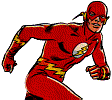See Also: Flash II: Barry Allen, Central City

Earth-1 comprises most of the super-hero comics published by DC Comics from the mid 1950s through 1985—essentially, all of DC’s Silver Age and Bronze Age material. Earth-1 ceased to exist in the wake of Crisis on Infinite Earths, when it was combined with Earth-2 and several other universes.
Some key differences between Earth-1 and the modern DC Universe include:
- The Justice Society never existed on Earth-1.
- Superman’s cousin, Kara Zor-El, also survived Krypton and became Supergirl.
- The Legion of Super-Heroes is virtually unrecognizable.
- Lex Luthor was a criminal scientist, rather than a respected (but secretly criminal) businessman.
- Wonder Woman was a founding member of the JLA rather than appearing several years later.
- As for the Flash, Central City was located in Ohio, and Keystone City did not exist.
- Comic book writers on Earth-1 were subconsciously aware of events on Earth-2.
The Silver Age of comics came about after super-heroes had lost popularity in the early 1950s. In 1956, DC editor Julius Schwartz tried to relaunch some characters with a new sci-fi twist, starting with the Flash in Showcase #4. The new Flash was a hit, and more revamped and original characters followed.
In 1961, “Flash of Two Worlds” (Flash #123) featured the modern Flash crossing over to an alternate world and meeting the original Flash. This story established the DC multiverse and naming scheme.
Earth-1 continued to be the primary setting for DC comics until 1985, when the publisher combined everything into one universe. While some series were relaunched (such as Superman, Wonder Woman and the Flash), most continued through the Crisis on Infinite Earths with few outward changes.
Text by Kelson Vibber. Do not copy without permission. Art
Art
- Showcase #4 (September–October 1956) - Carmine Infantino and Joe Kubert